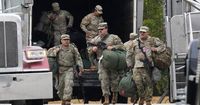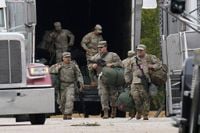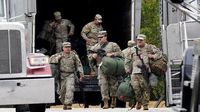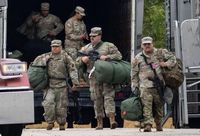On October 14, 2025, the Texas National Guard confirmed that seven of its members had been sent home from Illinois after failing to meet physical fitness requirements—a move that has ignited debate about military standards, public scrutiny, and the politics of deploying troops in times of civil unrest. The decision, announced by the Texas Military Department (TMD), came after widely circulated photos on social media showed several guardsmen at the Elwood Army Reserve Training Center outside Chicago whose physical appearance drew criticism and questions about compliance with military fitness standards.
The seven soldiers, part of a roughly 200-member Texas National Guard contingent dispatched to Illinois on October 7, 2025, were intended to support federal personnel and protect property during a wave of anti-immigration protests. The deployment, ordered by President Donald Trump, was met with resistance from Illinois officials and quickly became entangled in legal and public relations battles. According to Fox News and the San Antonio Express-News, the soldiers were identified and replaced during the pre-mission validation process at the Elwood training center, a step that typically includes dental, physical, mental health, and financial exams. However, the hurried nature of the deployment—troops were mobilized within 24 hours—meant some who did not meet the standards initially slipped through.
The Guard’s statement, provided to multiple outlets including the Chicago Tribune and Fox News Digital, did not specify which requirements the seven failed to meet but echoed the message of U.S. Defense Secretary Pete Hegseth. “Our standards will be high, uncompromising, and clear,” the TMD spokesperson said, reinforcing Hegseth’s recent campaign to elevate physical and grooming standards across the military.
Hegseth, who addressed hundreds of generals and admirals in Quantico, Virginia, on September 30, 2025, left little room for ambiguity. “It’s completely unacceptable to see fat generals and admirals in the halls of the Pentagon and leading commands around the world. It’s a bad look,” he declared, according to Task & Purpose. He went further, insisting, “Either you can meet the standard, either you can do the job, either you are disciplined, fit and trained, or you are out.” Hegseth also announced 10 new directives, including mandatory biannual physical fitness tests for active-duty troops and daily workouts, as part of a broader push to enforce what he called “the highest male standard” for combat positions.
Social media played a pivotal role in the saga. After photos of the Texas contingent arriving in Illinois went viral, critics questioned how the troops fit with Hegseth’s uncompromising vision. The images, showing several heavier guardsmen, prompted ridicule and sparked a debate about the image and effectiveness of the U.S. military. Hegseth used the moment to reinforce his stance, posting on X (formerly Twitter), “Standards are back at The @DeptofWar,” alongside a screenshot of a headline about the Texas National Guard’s decision.
The controversy unfolded against a backdrop of escalating protests and a legal tug-of-war over the National Guard’s presence in Illinois. President Trump had justified the deployment by citing failures of local authorities to control demonstrations outside Immigration and Customs Enforcement (ICE) facilities, particularly in Broadview, a suburb of Chicago. Illinois Governor JB Pritzker and state officials, however, challenged the necessity and constitutionality of the move, filing suit to halt the deployment.
On October 9, 2025, U.S. District Judge April Perry, an appointee of former President Joe Biden, issued a two-week restraining order against the mobilization. In her oral ruling, Perry stated there was “no credible evidence of a rebellion in Illinois” and voiced concerns that National Guard troops were “not trained in de-escalation or other extremely important law enforcement functions that would help to quell these problems.” She warned that allowing the troops into Chicago “will only add fuel to the fire that the defendants themselves have started.”
The Trump administration quickly appealed, arguing in a filing that the judge’s order “improperly impinges on the Commander in Chief’s supervision of military operations, countermands a military directive to officers in the field, and endangers federal personnel and property.” On October 11, the 7th U.S. Circuit Court of Appeals granted a partial stay, allowing troops already in Illinois to remain federalized—summoned to active duty under presidential command—but temporarily blocking their active deployment. As Fox News reported, the temporary restraining order kept the troops in place pending further court arguments, but barred them from patrolling or protecting federal property.
Meanwhile, the Pentagon has been notably silent about what the remaining Guard members will be doing while the legal wrangling continues. Uniformed troops have been spotted at the U.S. Army Reserve Center, with a few carrying rifles as they walked the 3,600-acre property southwest of Chicago, but their specific duties remain unclear. Before the judge’s ruling, the Texas Guard had also been seen at an ICE detention center in Broadview, though they reportedly did not interact with protesters.
The episode has highlighted the unique status of National Guard soldiers, who are mostly reservists balancing civilian careers with military obligations. According to the San Antonio Express-News, the standard screening process for deployment, known as SRP 1, can take days to complete, but the urgency of the Illinois mission compressed that timeline dramatically. As one anonymous Guard member explained, “The hurried nature of the deployment to Illinois allowed a small number of soldiers to slip through even though they fell short of standards.”
The broader implications of the incident are still being debated. For some, the swift removal of the seven guardsmen is a necessary step in upholding the credibility and effectiveness of the U.S. military. For others, the public shaming of service members over their appearance raises uncomfortable questions about the balance between readiness, morale, and the image the military projects to both allies and adversaries. Hegseth’s unapologetic stance—“The era of politically correct, overly sensitive, don’t hurt anyone’s feelings leadership ends right now”—has found support among those who see military discipline as paramount, but has also sparked criticism from those who worry about exclusion and morale.
As legal battles over the deployment continue and the Pentagon weighs its next steps, the story of the seven recalled Texas guardsmen stands as a flashpoint in the ongoing struggle to define what it means to serve—and to lead—in today’s U.S. military. The events in Illinois have become a microcosm of larger debates about standards, accountability, and the evolving role of the armed forces in a divided nation.



